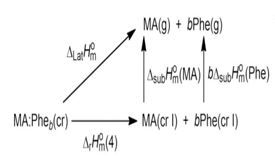
First and Second Dissociation Enthalpies in Bi-Component Crystals Consisting of Maleic Acid and L-Phenylalanine
I.O. Feliciano, D.P. Silva, M.F.M. Piedade, C.E.S. Bernardes, M.E. Minas da Piedade
Molecules 2021, 25, 5714.
Abstract
The energetics of the stepwise dissociation of a A:B2 bi-component crystal, according to A:B2(cr) → A:B(cr) + B(cr) and A:B(cr) → A(cr) + B(cr), was investigated using MA:Phe2 and MA:Phe (MA = maleic acid; Phe = L-phenylalanine) as model systems. The enthalpy changes associated with these sequential processes and with the overall dissociation reaction A:B2(cr) → A(cr) + 2B(cr) were determined by solution calorimetry. It was found that they are all positive, indicating that there is a lattice enthalpy gain when MA:Phe2 is formed, either from the individual precursors or by adding Phe to MA:Phe. Single-crystal X-ray diffraction (SCXRD) analysis showed that MA:Phe2 is best described as a protic salt containing a maleate anion (MA-) and two non-equivalent L-phenylalanine units, both linked to MA- by NH···O hydrogen bonds (H-bond): one of these units is protonated (HPhe+) and the other zwitterionic (Phe±). Only MA- and HPhe+ molecules are present in the MA:Phe lattice. In this case, however, NH···O and OH···O H-bonds are formed between each MA- unit and two HPhe+ molecules. Despite these structural differences, the enthalpy cost for the removal of the zwitterionic Phe± unit from the MA:Phe2 lattice to yield MA:Phe is only 0.9 ± 0.4 kJ mol-1 higher than that for the dissociation of MA:Phe, which requires a proton transfer from HPhe+ to MA- and the rearrangement of L-phenylalanine to the zwitterionic, Phe±, form. Finally, a comparison of the dissociation energetics and structures of MA:Phe and of the previously reported glycine maleate (MA:Gly) analogue indicated that parameters, such as the packing coefficient, density, hydrogen bonds formed, or fusion temperature, are not necessarily good descriptors of dissociation enthalpy or lattice enthalpy trends when bi-component crystals with different molecular composition are being compared, even if the stoichiometry is the same.
Return Previous Next